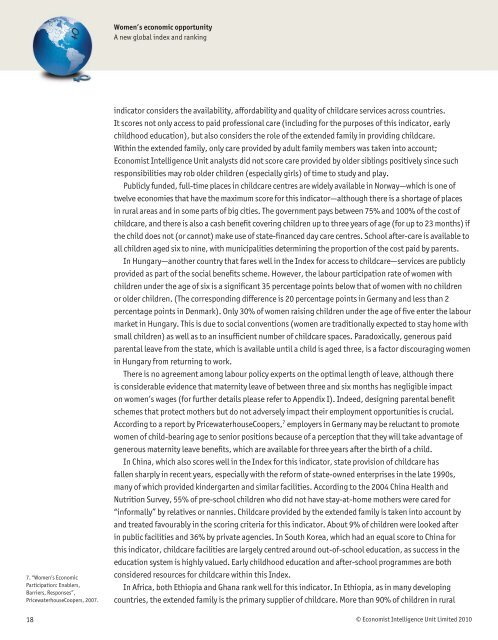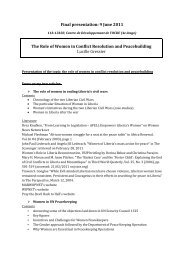Women's Economic Opportunity Index - Economist Intelligence Unit
Women's Economic Opportunity Index - Economist Intelligence Unit
Women's Economic Opportunity Index - Economist Intelligence Unit
- No tags were found...
Create successful ePaper yourself
Turn your PDF publications into a flip-book with our unique Google optimized e-Paper software.
Women’s economic opportunityA new global index and ranking7. “Women’s <strong>Economic</strong>Participation: Enablers,Barriers, Responses”,PricewaterhouseCoopers, 2007.18indicator considers the availability, affordability and quality of childcare services across countries.It scores not only access to paid professional care (including for the purposes of this indicator, earlychildhood education), but also considers the role of the extended family in providing childcare.Within the extended family, only care provided by adult family members was taken into account;<strong>Economist</strong> <strong>Intelligence</strong> <strong>Unit</strong> analysts did not score care provided by older siblings positively since suchresponsibilities may rob older children (especially girls) of time to study and play.Publicly funded, full-time places in childcare centres are widely available in Norway—which is one oftwelve economies that have the maximum score for this indicator—although there is a shortage of placesin rural areas and in some parts of big cities. The government pays between 75% and 100% of the cost ofchildcare, and there is also a cash benefit covering children up to three years of age (for up to 23 months) ifthe child does not (or cannot) make use of state-financed day care centres. School after-care is available toall children aged six to nine, with municipalities determining the proportion of the cost paid by parents.In Hungary—another country that fares well in the <strong>Index</strong> for access to childcare—services are publiclyprovided as part of the social benefits scheme. However, the labour participation rate of women withchildren under the age of six is a significant 35 percentage points below that of women with no childrenor older children. (The corresponding difference is 20 percentage points in Germany and less than 2percentage points in Denmark). Only 30% of women raising children under the age of five enter the labourmarket in Hungary. This is due to social conventions (women are traditionally expected to stay home withsmall children) as well as to an insufficient number of childcare spaces. Paradoxically, generous paidparental leave from the state, which is available until a child is aged three, is a factor discouraging womenin Hungary from returning to work.There is no agreement among labour policy experts on the optimal length of leave, although thereis considerable evidence that maternity leave of between three and six months has negligible impacton women’s wages (for further details please refer to Appendix I). Indeed, designing parental benefitschemes that protect mothers but do not adversely impact their employment opportunities is crucial.According to a report by PricewaterhouseCoopers, 7 employers in Germany may be reluctant to promotewomen of child-bearing age to senior positions because of a perception that they will take advantage ofgenerous maternity leave benefits, which are available for three years after the birth of a child.In China, which also scores well in the <strong>Index</strong> for this indicator, state provision of childcare hasfallen sharply in recent years, especially with the reform of state-owned enterprises in the late 1990s,many of which provided kindergarten and similar facilities. According to the 2004 China Health andNutrition Survey, 55% of pre-school children who did not have stay-at-home mothers were cared for“informally” by relatives or nannies. Childcare provided by the extended family is taken into account byand treated favourably in the scoring criteria for this indicator. About 9% of children were looked afterin public facilities and 36% by private agencies. In South Korea, which had an equal score to China forthis indicator, childcare facilities are largely centred around out-of-school education, as success in theeducation system is highly valued. Early childhood education and after-school programmes are bothconsidered resources for childcare within this <strong>Index</strong>.In Africa, both Ethiopia and Ghana rank well for this indicator. In Ethiopia, as in many developingcountries, the extended family is the primary supplier of childcare. More than 90% of children in rural© <strong>Economist</strong> <strong>Intelligence</strong> <strong>Unit</strong> Limited 2010




